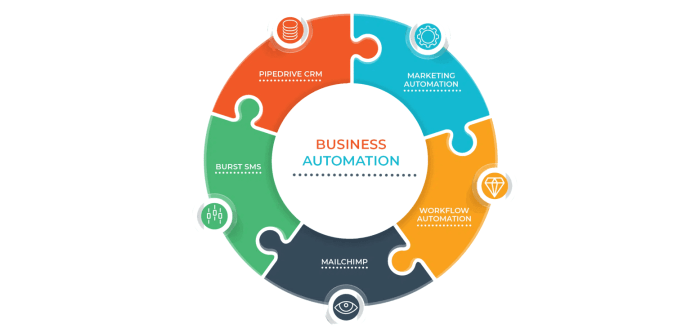Best IT automation tools for small businesses set the stage for this enthralling narrative, offering readers a glimpse into a story that is rich in detail and brimming with originality. In today's fast-paced business world, efficiency is key, and IT automation tools play a crucial role in achieving this goal.
As we delve deeper into the realm of IT automation tools, we uncover the myriad benefits and possibilities that await small businesses looking to streamline their operations and boost productivity.
Overview of IT Automation Tools

IT automation tools are software solutions designed to streamline and simplify repetitive tasks within small businesses. These tools are crucial for enhancing efficiency, reducing human error, and saving time and resources.
Benefits of Using Automation Tools
- Improved Efficiency: Automation tools can perform tasks faster and more accurately than humans, allowing employees to focus on more strategic activities.
- Cost Savings: By automating repetitive tasks, businesses can reduce labor costs and increase productivity.
- Enhanced Accuracy: Automation tools eliminate the risk of human error, ensuring consistent and reliable results.
- Increased Productivity: With automation, businesses can complete tasks in less time, leading to higher output and improved performance.
Common Tasks that can be Automated
- File Backup and Recovery: Automated tools can schedule regular backups of important files and ensure quick recovery in case of data loss.
- Software Updates: IT automation tools can automatically install software updates to ensure systems are up-to-date and secure.
- Network Monitoring: Tools can continuously monitor network performance, detect issues, and take corrective actions without human intervention.
- Customer Communication: Automation tools can send out personalized messages, notifications, and reminders to customers based on predefined triggers.
Factors to Consider When Choosing IT Automation Tools
When selecting IT automation tools for small businesses, it is crucial to consider various factors to ensure that the chosen tools are the best fit for the organization's needs and goals. Below are some key factors to keep in mind:
Types of IT Automation Tools Available
- Scripting Tools: These tools allow users to write scripts to automate repetitive tasks and processes.
- Workflow Automation Tools: These tools help in automating entire workflows by defining a series of tasks and their dependencies.
- Configuration Management Tools: These tools enable the management and automation of configurations across multiple devices and systems.
- Monitoring and Alerting Tools: Tools that automate the monitoring of systems and networks and send alerts in case of any issues.
Scalability and Flexibility of IT Automation Tools
- Scalability: Consider whether the automation tools can grow with your business and handle increasing workloads without significant changes.
- Flexibility: Look for tools that are flexible enough to adapt to changing business requirements and integrate with other systems and tools.
- Customization: Check if the automation tools allow for customization to meet specific needs and workflows of the business.
- Compatibility: Ensure that the selected tools are compatible with the existing infrastructure and technology stack of the organization.
Top IT Automation Tools for Small Businesses
Implementing IT automation tools can greatly benefit small businesses by improving efficiency and productivity. Here are some popular IT automation tools suitable for small businesses:
1. Zapier
Zapier is a web-based automation tool that allows users to connect different apps and automate workflows without any coding knowledge. It offers a wide range of integrations with popular apps like Gmail, Slack, and Trello, making it easy for small businesses to streamline their processes.
Real-life example: A small marketing agency used Zapier to automatically create new projects in their project management tool whenever a new client was added to their CRM system, saving time and reducing manual errors.
2. Microsoft Power Automate
Formerly known as Microsoft Flow, Power Automate is a powerful automation tool that integrates with Microsoft Office 365 and other Microsoft applications. It allows users to automate repetitive tasks, create workflows, and trigger actions based on certain conditions.
Real-life example: A small e-commerce business used Power Automate to automatically send personalized thank you emails to customers after they made a purchase, leading to increased customer satisfaction and loyalty.
3. Trello
Trello is a popular project management tool that offers automation features through its Butler Power-Up. Users can create custom automation rules to streamline their workflows, automate repetitive tasks, and improve collaboration within teams.
Real-life example: A small software development team used Trello's automation features to automatically assign tasks to team members based on project deadlines, ensuring timely delivery of projects and improved team efficiency.
Implementation and Integration of IT Automation Tools

Implementing and integrating IT automation tools in a small business environment can significantly improve efficiency and productivity. It is important to follow best practices to ensure a smooth transition and maximize the benefits of automation.
Best Practices for Implementing IT Automation Tools
- Define clear objectives: Identify the specific tasks or processes that can benefit from automation and set clear goals for implementation.
- Start small: Begin with one or two automation tools to pilot the process before scaling up to automate more functions.
- Involve key stakeholders: Get buy-in from employees and managers who will be using the automation tools to ensure successful implementation.
- Provide adequate training: Offer training sessions to educate employees on how to use the automation tools effectively and efficiently.
Integrating Automation Tools with Existing Systems and Workflows
- Assess compatibility: Ensure that the automation tools are compatible with your existing systems and workflows to avoid disruptions.
- Customize integration: Tailor the automation tools to fit your business processes and integrate them seamlessly with your current systems.
- Test thoroughly: Conduct thorough testing to identify any issues or bugs before fully integrating the automation tools into your workflow.
Tips for Training Employees on Using Automation Tools
- Provide hands-on training: Offer practical training sessions where employees can practice using the automation tools in real-world scenarios.
- Offer ongoing support: Provide resources and support for employees as they learn to use the automation tools effectively.
- Celebrate successes: Recognize and reward employees who demonstrate proficiency in using the automation tools to encourage adoption and usage.
Closure
In conclusion, the discussion on the best IT automation tools for small businesses leaves us with a clear understanding of how these tools can revolutionize the way businesses operate. By embracing automation, small businesses can pave the way for a more efficient and successful future.
Helpful Answers
What are some common tasks that can be automated using IT tools?
Common tasks that can be automated include data entry, file backups, system updates, and email marketing campaigns.
How can small businesses integrate automation tools with existing systems?
Small businesses can integrate automation tools by ensuring compatibility with current software, conducting thorough testing, and providing adequate training to employees.
What factors should small businesses consider when choosing IT automation tools?
Key factors to consider include cost, scalability, ease of use, customer support, and compatibility with existing systems.





![What is IT Project Management? [2023] • Asana](https://business.mardinata.com/wp-content/uploads/2025/10/project-management-industries-120x86.jpg)




